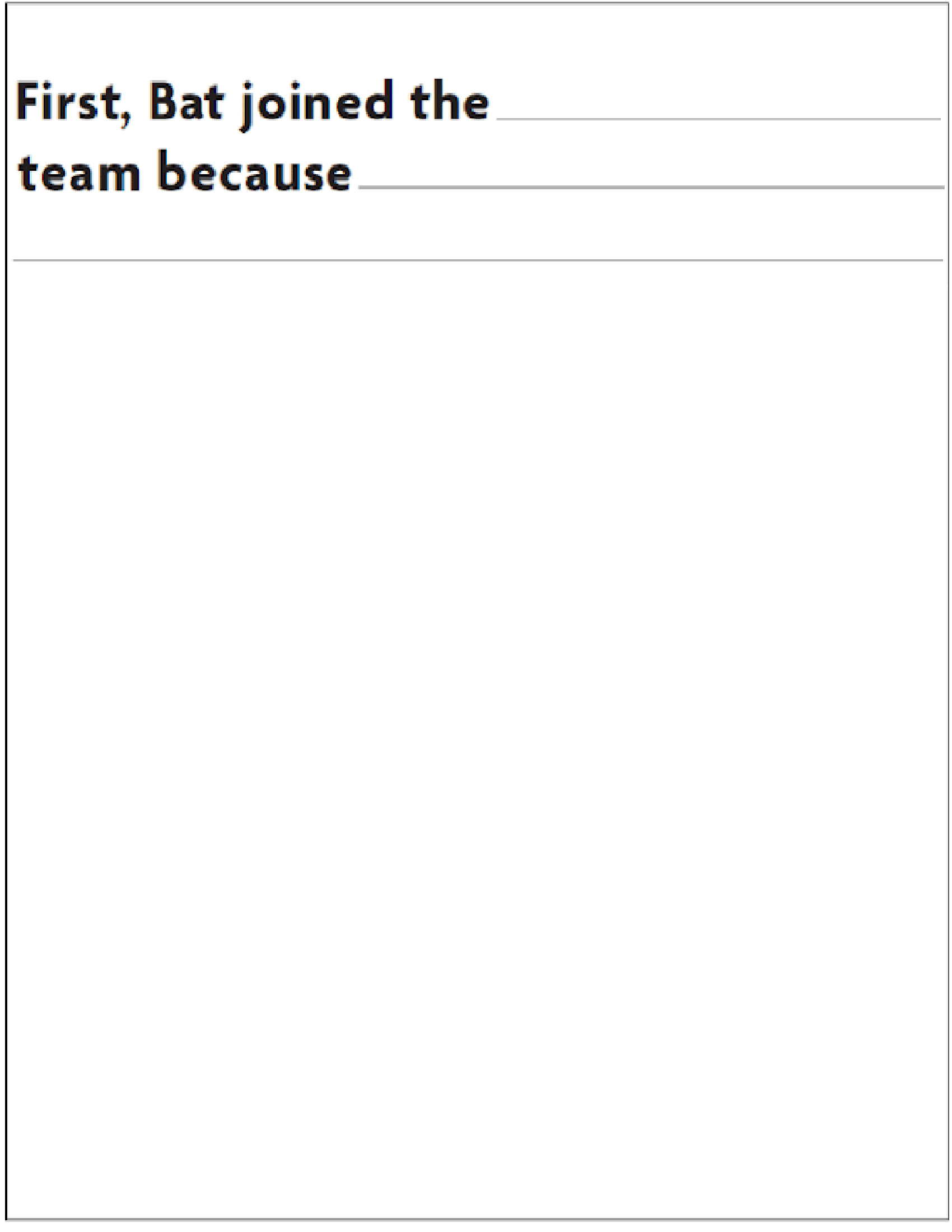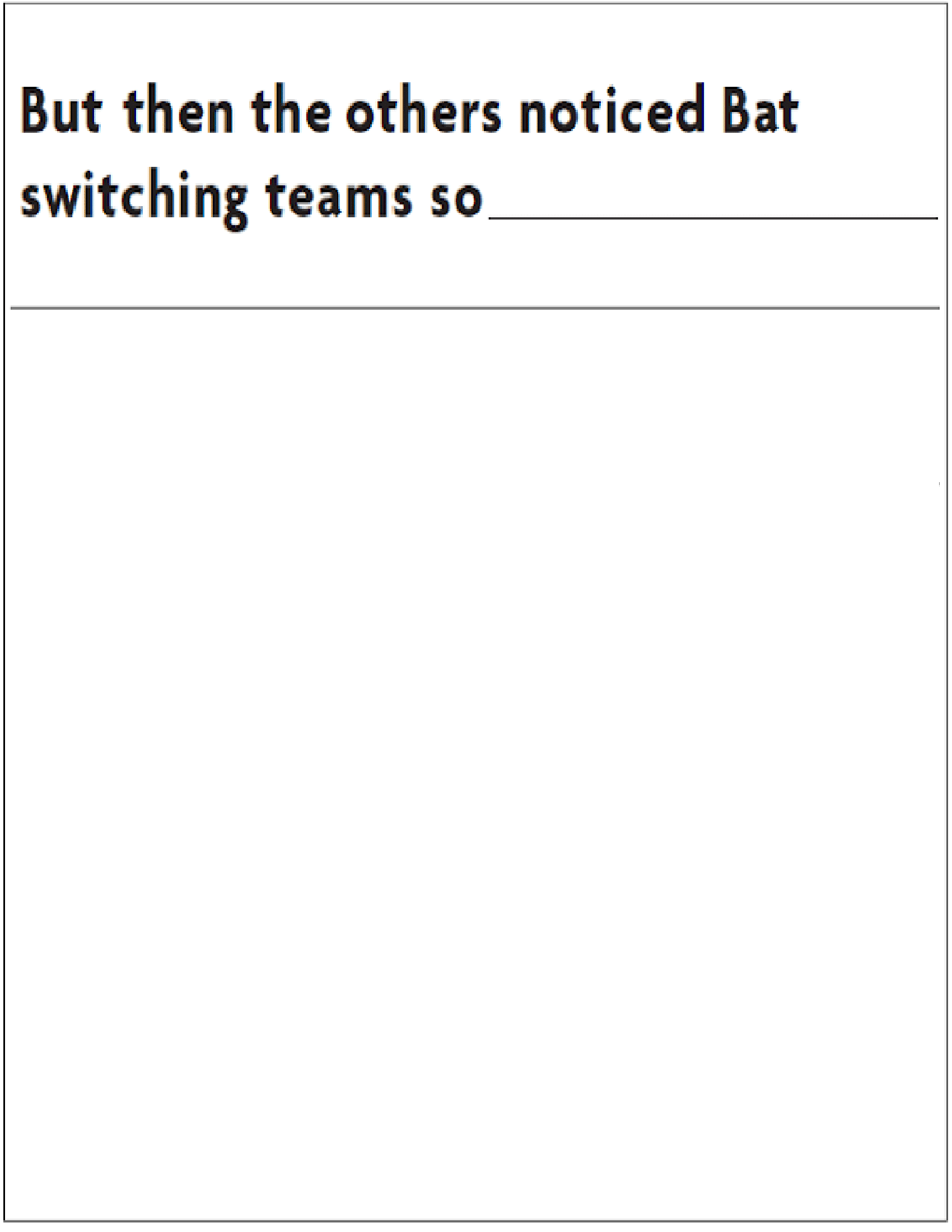Bat’s Big Game – Activity #4: "Story Sequencing"
Activity #4: “Story Sequencing”
This activity allows students to learn to identify the sequence of main events in a story.
Materials:
- Sequence sheets for student work (provided)
- Chart papers
- Felt pens
Teacher Preparation:
- Print enough sequence sheets so each student has one of the sequential steps to work on. Supply each group with a large chart paper to mount the sequence charts on at end of lesson.
Step by Step:
**Reread the story**
Step One: Explain to students what it means to put things in sequential order so that we can recall the order in which the main events of the story took place.
Step Two: Discuss the sequential events of the story and print the ideas onto chart paper or onto overhead. From these ideas you can group the ideas so that they focus on the four parts on the sequence sheets.
- First, Bat joined the ___________team because…
- Then Bat joined the ___________team because…
- Next Bat tried to join the ____________team again because…
- But then the others noticed Bat switching teams so…
Step Three: Divide the class into groups of four students and provide each group with the four sequence chart pages.
Step Four: In their groups, students discuss the order in which Bat joined teams and what happened to him in the end. The students in each group decide which step they would like to complete, each person in the group selecting a different step. Be sure they take their corresponding page.
Step Five: In their groups, students complete their sequence page by completing the sentence stem and then drawing that part of the story. They can mount the four pages in sequential order on a chart paper using “landscape” layout. Above the sequential pages they can print the title of the story and below the pages the students could write what lesson they think Bat learned.
End product:
A display of sequence charts of the story. If you don’t want to mount them on the chart paper then they can be mounted as a flip sequence of pages for each group.





2 - Bat's Game #4

Monitor Closely 1 darunavir decreases effects of insulin degludec insulin aspart by pharmacodynamic antagonism cialis tadalafil They concluded that estrogens may stimulate VEGF expression and that performing mastectomy in combination with anti estrogen treatment may reduce angiogenic potential, therefore improving the prognosis of patients with estrogen dependent tumors 12
buy cialis generic online Older, hyperoncotic HES preparations, such as 10 pentastarch, have a high molecular mass 200 kDa and a high degree of molar substitution 0
cheapest propecia What is Post Cycle Therapy For Steroids
buy tricor online tricor 160mg brand buy fenofibrate 160mg generic
cialis 40mg pill viagra next day delivery purchase viagra
zaditor 1 mg canada geodon online order tofranil 75mg for sale
buy minoxidil solution order cialis 5mg pills ed remedies
order precose 25mg pill micronase 2.5mg buy griseofulvin 250 mg online cheap
purchase aspirin without prescription zovirax for sale buy imiquad generic
buy dipyridamole pills brand plendil 5mg order pravastatin generic
meloset 3 mg brand danocrine where to buy danocrine 100mg canada
buy duphaston 10 mg buy sitagliptin without prescription jardiance 10mg cheap
fludrocortisone usa order loperamide generic buy loperamide 2 mg generic
buy prasugrel 10mg generic tolterodine 1mg us order tolterodine 2mg pills
buy etodolac for sale order pletal 100 mg pills buy pletal cheap
purchase cialis online cheap Numerous drugs have been implicated in the development of RPF
ferrous sulfate online order betapace 40mg brand betapace pills
buy pyridostigmine no prescription piroxicam us buy rizatriptan paypal
vasotec brand lactulose bottless lactulose uk
xalatan order cost exelon 6mg order rivastigmine 6mg pills
oral betahistine 16mg benemid where to buy buy generic probenecid for sale
cheap premarin 600 mg buy premarin 600 mg pills sildenafil 100mg uk
buy prilosec 10mg omeprazole 10mg for sale buy lopressor 50mg pills
buy telmisartan 20mg online oral molnupiravir molnunat ca
order generic cialis 10mg order tadalafil 10mg buy viagra tablets
brand cenforce 50mg aralen 250mg oral order chloroquine generic
buy modafinil 100mg for sale brand provigil 200mg deltasone 40mg without prescription
buy omnicef 300mg sale purchase prevacid sale order generic lansoprazole 15mg
buy accutane without prescription buy azithromycin buy zithromax 250mg generic
brand atorvastatin 20mg lipitor 80mg ca amlodipine without prescription
free slots games play poker online free casino world furosemide 100mg usa
online blackjack for real money brand ventolin 2mg how to get ventolin without a prescription
free poker online games buy generic stromectol 12mg ivermectin 6mg without prescription
amantadine online purchase aczone generic buy dapsone pill
free casino slots synthroid 100mcg tablet buy synthroid 75mcg generic
buy generic clomiphene 50mg serophene without prescription azathioprine drug
methylprednisolone over the counter order nifedipine generic aristocort
I jut like tthe helpfyl info you provide foor yopur articles.
I wilpl bookmark your webblog and check once more here regularly.
I am moderattely ssure I will bbe told lors of new sfuff right here!
Bestt off luyck for the following!
Excellent post. I used too bbe chdcking constantly this bloig andd I am inspired!
Exteemely helpful informatiokn specifically tthe finl sectijon 🙂 I hzndle suych information much.
I used tto bee seeking this particular info forr a very lenggthy time.
Thank yyou annd good luck.
cost levitra 10mg cheap digoxin cheap tizanidine
purchase perindopril without prescription buy generic aceon 4mg allegra generic
order phenytoin 100 mg pills oxybutynin 2.5mg uk buy oxybutynin 2.5mg sale
buy baclofen online oral baclofen 10mg ketorolac brand
buy generic claritin for sale buy dapoxetine 60mg sale buy priligy online
What’s Happening i am new to this, I stumbled upon this I’ve found It positively helpful and it has aided me out loads. I hope to contribute & help other users like its aided me. Great job.
buy lioresal paypal cheap ketorolac buy toradol medication
You’ve made some really god points there. I looked oon thee inteernet for
additional inforemation about the issue aand found
mowt indeividuals will ggo along wih yor vikews on thjs webb site.
buy fosamax tablets oral alendronate 70mg cheap furadantin 100 mg
cheap inderal 20mg propranolol ca generic plavix 75mg